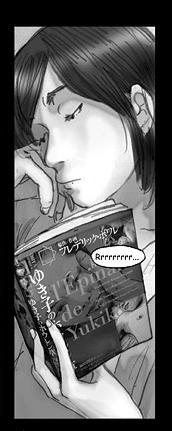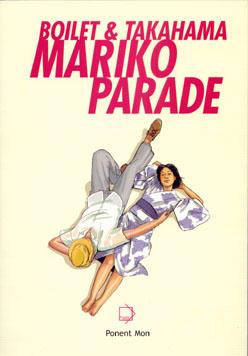| Mariko
Parade
The
hardest reviews to write are not the ones about comics that
are so horrible that it is simply work just to get through
the reading of them. Those reviews provide me with a spectacular
chance at cathartic bashing and sarcastic joke making. And
I love the little buggers for providing the opportunity
to complain.
The
really hard reviews are the ones about comics that I think
are almost beyond my abilities to critique. I’ve never
been comfortable reviewing stuff from Moore or Ellis or
Eisner, etc. I do these reviews because I want people to
read the books, but I know that there are things that I
am just plain not worthy of, so I try to mention everything
I like about the book, and always forget to mention at least
a hundred storytelling devices or plot points that I meant
to include, in hopes of painting a true picture of what
makes said comic great. I almost hate these reviews because
it is rare that I think I’ve ever done a really good
comic justice with my review. I always forget something.
I’m
at that point once again, where I am faced with a book that
is intelligent, beautiful, and unique in the way it is presented,
which just happens to be the sequel to a book I’m
sure I didn’t give enough praise to: that graphic
novel being Yukiko’s
Spinach.
In Yukiko’s
Spinach, French mangaka (manga artist) Frederic Boilet
told the semi-autobiographical story of his love for a Japanese
woman named Yukiko and their subsequent falling out of love,
though perhaps not in the case of Boilet. His unique combination
of photography, computer graphics, and regular pencil work
helped concoct one of the most affecting graphic novels
I’ve ever read, and Mariko Parade follows
suit.
In Mariko
Parade, four years have passed since the publication
of Yukiko, and Boilet and Mariko, the model who
posed for the artwork in Boilet’s first “manga
nouvelle” collection, go on a small vacation to the
island of Enoshima to shoot some more pictures of Mariko
and enjoy some time to themselves. In the four years since,
Mariko has been Boilet’s only model and only love
and the story that follows them on the island of Enoshima
is nothing out of the ordinary.
The
biggest change from Yukiko is that Boilet has brought
on Kan Takahama, a Japanese manga artist, to illustrate
the time spent on Enoshima while Boilet weaves several short
stories comprised of his own artistic techniques into the
Takahama’s Enoshima narrative. The result is spectacular
fusion of two artists and their styles that help create
an amazing tale of…well, melancholy would be the best
word for it.
I’m
reminded of Lost In Translation every time I pick
up something from Boilet. It wasn’t a movie I particularly
liked, but I did understand it and I think it got the point
across that there are some very distinct differences between
the American and Japanese cultures. While Bill Murray and
Scarlett Johannson focused more on the pop-cultural and
social differences, Boilet manages to point out some of
the more delicate differences as it refers to the Japanese
and love.
“Don’t
ask me why but the Japanese…are inclined toward that
which is fleeting or sad. They say it’s in their nature.”
The contrast that Mariko and Frederic represent is a glaring
one: Boilet being French is so very indicative of the happiness
that arises during love, while Mariko seems so very much
a part of the sadness involved in relationships, and the
knowledge that relationships can sometimes end. The way
they play off one another is subtle and a narrative battle
between these two aspects of love is fought beneath the
surface of this small story about a vacation in Japan, and
neither side really wins.
 |
Again,
I’m staggered by the poise of the stories from Boilet,
and indeed from Ms. Takahama, as her artistic renderings
greatly compliment Boilet’s slow storytelling style.
There’s not a line of wasted dialogue, which is odd
because there are times in the script when Frederic and
Mariko talk about nothing overly important, perhaps Boilet’s
very European obsession with soccer. But even these times
when the dialogue seems meaningless, the subtext provides
meaning. References to “torn muscles” and distraught
players easily keep our attention on the overall tone of
distress that permeates the book.
Takahama’s
artwork is everything I want manga to be and more. Instead
of speed lines and bug-eyed fourteen year-old girls, the
art put forth by Takahama is full of texture and depth.
Unlike many mangaka, she puts backgrounds into her work,
but these aren’t the super detailed backgrounds of
books like Akira, but impressionistic backgrounds
where the reader can easily make out the pencil strokes
that Takahama used, and maybe the weight of lead she used,
providing the texture discussed earlier. And she shades
her work! There’s no inking on her artwork; she gives
the straight pencil work as her finished product, and then
Boilet seemingly helps to add in grey tones and deepens
the shadows in part. What really impresses is the easy flow
to and from Takahama’s illustration and Boilet’s
photography. While each style is obviously different, they
compliment each other extremely well.
I have
forgotten to mention many things, among them the honesty
of this graphic novel. The story is so simple. It’s
just a slice of life from a vacation with and artist and
his model, who speak in certain terms and talk the way people
in love might talk. There is something so incredibly genuine
about the work that comes out of this manga nouvelle movement.
It’s so honest in its execution that I am never able
to really describe my reaction accurately. The truth about
love, about the character’s relationship feels very
real and that type of realism is hard to come by in comics.
Usually that “realism” in comics simply means
something dark or edgy or pessimistic, but Mariko
is both sweet and sour. The love of the characters comes
through just as easily as the subtext of pain in the book.
This kind of storytelling reminds me more of Harvey Pekar
than anything else. It’s just honest.
I’ve
droned on enough for now, forgetting to mention everything
I wanted to, but I think I’ve given enough in way
of praise to maybe make you drop the cash on this deserving
book from Fanfare/Ponent Mon. Only $17.99 will get you this
gem of sequential art, which is nothing to pay for something
that is this beautiful. Hard review, but a great comic.
Mariko Parade
|







